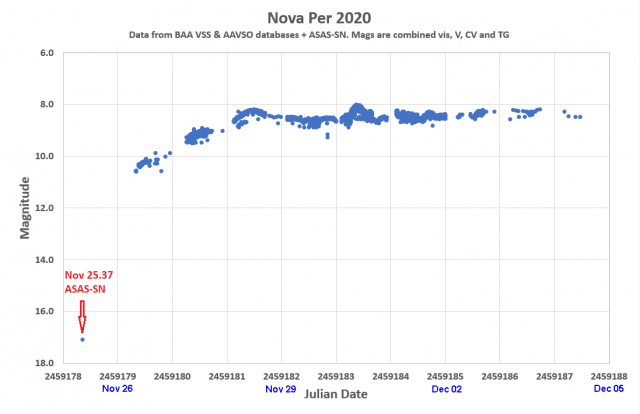Forum Replies Created
-
AuthorPosts
-
 Jeremy ShearsParticipant
Jeremy ShearsParticipantHere’s a light curve of the Nova which Philip Jennings just showed at the BAA meeting.
Prepared yesterday (Dec 4). Latest obs early this AM put it at mag 8.9

 Jeremy ShearsParticipant
Jeremy ShearsParticipantStill bright – last evening I had the nova at V~8.3. Technically this is an easy binocular target, especially now the Moon is receding.
 Jeremy ShearsParticipant
Jeremy ShearsParticipantThis nova is still bright. I had it about mag 8.5 last night.
 Jeremy ShearsParticipant
Jeremy ShearsParticipantThe nova now has an official variable star designation: V1112 Persei
 Jeremy ShearsParticipant
Jeremy ShearsParticipantyes indeed. I had it at mag 8.9 at 18.30 this evening.
 Jeremy ShearsParticipant
Jeremy ShearsParticipantYou need a smaller telescope, Nick! I was using 5 sec exposures on the C11.
Good target for visual observers even with relatively small instruments.
Super to have another northerly nova.
 Jeremy ShearsParticipant
Jeremy ShearsParticipantThanks for alerting about the ATel, Robin – pleased to see it’s now officially a classical nova.
 Jeremy ShearsParticipant
Jeremy ShearsParticipantPosted image on my Members Page here.
 Jeremy ShearsParticipant
Jeremy ShearsParticipantCharts and sequences of the transient are now available from the AAVSO website.
 Jeremy ShearsParticipant
Jeremy ShearsParticipantThe team responds to criticism of their announcement of phosphine discovery here. They say the ALMA data support PH3, but at lower concs than previously claimed. Standing by their conclusion, they call for further data.
 Jeremy ShearsParticipant
Jeremy ShearsParticipantWillmann-Bell shutting up shop is a sad development. The AIP4WIN software, which accompanies Richard Berry’s book “Astronomical Image Processing”, has been used by many people for photometry. The second edition, including AIP4WIN version 2 software, has been out of print for many years. According to Willmann-Bell, they are making a non-registered version available from their website, specifically stating “AIP4Win2.0 No Longer Requires On-line Registration”. Richard Berry comments in an AAVSO forum that it is now essentially freeware.
 Jeremy ShearsParticipant
Jeremy ShearsParticipantYes, with ER UMa stars having very frequent outbursts, there’s always something to see, Stewart. Great fun!
 Jeremy ShearsParticipant
Jeremy ShearsParticipantWelcome Rohit! Good to see you have started a BAA Members Page, too. I look forward to seeing some of your images uploaded to that. You find some excellent examples of astro-imaging on Members Pages.
Good luck!
 Jeremy ShearsParticipant
Jeremy ShearsParticipantCUP will no longer publish amateur astronomy books. See Owen’s comments on WB and CUP on this recent thread here.
 Jeremy ShearsParticipant
Jeremy ShearsParticipantHello Darren,
You have some excellent equipment for CCD observation of variables. For many years I too used a 100 mm refractor. For many branches of VS work you don’t need a filter, so that might be the place to start to see how you get on before buying a V filter.
This includes photometry of cataclysmic variables, such as looking for outbursts of dwarf nova. There is a thread on here about IX Dra at the moment; I use unfiltered CCD for that. Also have a look at the VSS CCD target list which was developed to provide people who are new to the field of CCD photometry of variable stars with some interesting targets to which they could turn their CCDs, whilst developing their techniques. The G filter could also be deployed if you wish. It’s close to V. The only processing you will need for photometry is the calibration you referred to.
 Jeremy ShearsParticipant
Jeremy ShearsParticipantThanks for the update, Stewart. It’s very nice result and my thanks to our observers, too.
I must admit this is not a star that I have observed before, but I will continue to do so as it’s always up to something. I hope others will do the same as we head towards the next superoutburst.
 Jeremy ShearsParticipant
Jeremy ShearsParticipantI have a fondness for Phosphorus chemistry. Reactions of phosphorus studied during A Level chemistry resulted in the necessary attendance of the local fire brigade in the chemistry lab. Great fun!
 Jeremy ShearsParticipant
Jeremy ShearsParticipantBright tonight: Oct 27.791 15.79C
 Jeremy ShearsParticipant
Jeremy ShearsParticipantThanks for the update, Stewart. Certainly a lively star!
 Jeremy ShearsParticipant
Jeremy ShearsParticipantA little fainter last night: Oct 9.852 at ~14.17C
-
AuthorPosts
